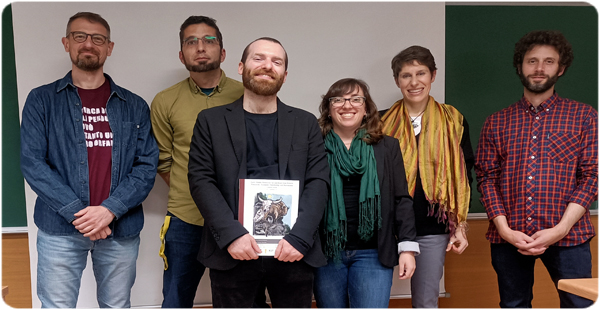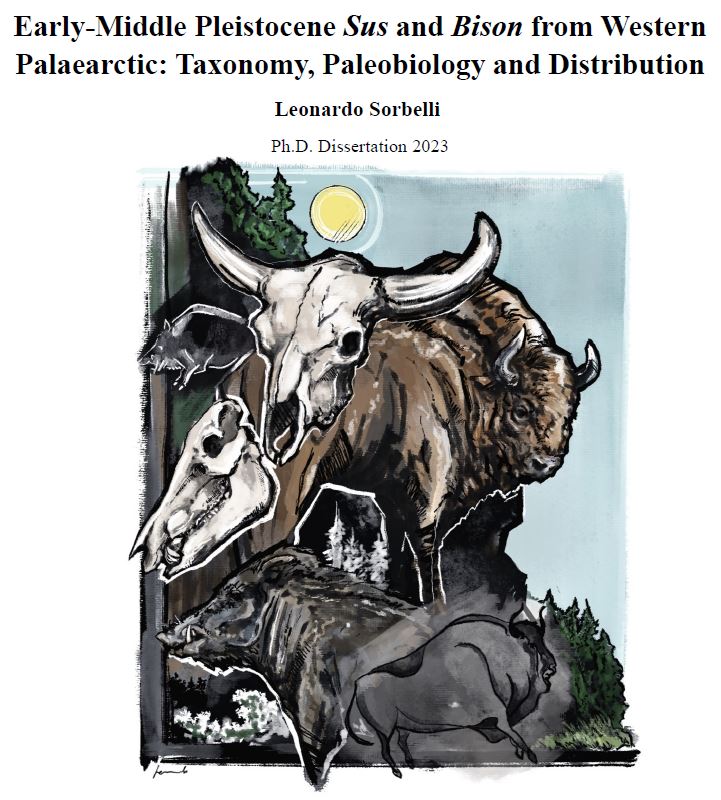The doctoral thesis "Early-Middle Pleistocene Sus and Bison from Western Palaearctic: Taxonomy, Paleobiology and Distribution" is nicluded in the PhD program in Geology at the Universitat Autònoma de Barcelona (UAB) and was supervised by Salvador Moyà-Solà, ICREA research professor at the Institut Català de Paleontologia Miquel Crusafont (ICP), Joan Madurell-Malapeira (UAB), and Marco Cherin (Università degli Studi di Perugia).
Main page of Leonardo Sorbelli PhD thesis
PhD summary (L. Sorbelli)
The Early Pleistocene is one of the most important periods for the evolution of the biosphere in the Western Palearctic. The long-term global cooling and the glacial dynamics intensified after 3.0 Ma and, stronger, at 1.4-1.2 Ma. This major turning point for the climate of the planet has been called the Early-Middle Pleistocene Transition (EMPT). The consequences of these new dynamics exacerbated the cooling and aridification of the climate, eventually triggering the progressive shrinking of the forested habitats replaced by open landscapes, and, consequentially, a major renewal in the flora and fauna. The European Early Pleistocene faunal assemblages’ taxonomic composition and their response to this environmental change have been subject to numerous publications and have provided significant biochronological data. The deep effects of the EMPT on the mammal communities of Europe were recognized with the formalization of the Epivillafranchian biochron (ca. 1.2–0.8 Ma). This biochronological unit represents the ‘transitional’ timespan in which Europe was characterized by the co-occurrence of some Villafranchian relicts and the first Galerian taxa, mostly arrived in the continent from Asia and Africa.
Despite the increased interest in the paleontological community and the new discoveries, not all the representative faunal elements of the Epivillafranchian are well defined and this biochron is still poorly characterized. Among large mammal genera that appeared during the Plio-Pleistocene and that have a major role in the Epivillafranchian transition, Sus and Bison stand out. Their importance within the trophic chains of the Pleistocene and Holocene and their ecological adaptability and abundance in the fossil record made these two clades extremely useful both as environmental indicators and biochronological markers. Nonetheless, the taxonomic history of the early representatives of these clades is quite confused and their dispersal in western Eurasia is still relatively obscure. Therefore, the main aim of this PhD thesis is to better understand the taxonomy, paleobiology, and chrono-spatial distribution of these two iconic genera during the latest stages of Early Pleistocene.
The study performed on the suid record from the Epivillafranchian sites of Cal Guardiola and Vallparadís Estació (1.2–0.6 Ma, NE Iberian Peninsula) attests to the presence of the verrucosic boar Sus strozzii in Europe between 1.0 and 0.86 Ma, after the so-called ‘suid gap’, during which this group experienced a major demographic collapse. The study is extended to other samples of Suinae from Europe and reveals that, contrarily to what was commonly believed, S. strozzii did not disappear before the Jaramillo subchron (ca. 1.0) but persisted until the Early-Middle Pleistocene boundary (ca 0.8 Ma), which therefore, can be considered a marker for this biochron. The bovid record from the late Villafranchian locality of Pietrafitta (central Italian Peninsula), originally attributed to Leptobos, is reappraised in this thesis and referred to the genus Bison. The primitive characters of the cranium, relatively small body size, and slender built indicate that the Pietrafitta sample can be referred to Bison (Eobison) degiulii, one of the earliest species of bison entering Europe after 1.8 Ma. The vague definition of the subgenus Eobison has triggered the reappraisal of its entire Eurasian record presented herein. The resulted emended diagnosis allows the recognition of, at least, three species of Eobison, spanning for more than 1.0 Ma in the whole Eurasia. The large bovid collection of the Vallparadís composite section provides new insights on the first ‘true’ bison entering Europe at the onset of the Epivillafranchian. This sample is here referred to the oldest member of the subgenus Bison, namely Bison (Bison) schoetensacki. A review of several Bison samples from Europe constrained between 1.2 and 0.6 Ma advocates the inclusion of this species among the major markers of the Epivillafranchian.
Main image Leonardo Sorbelli (front) with some of the supervisors and tribunal members














